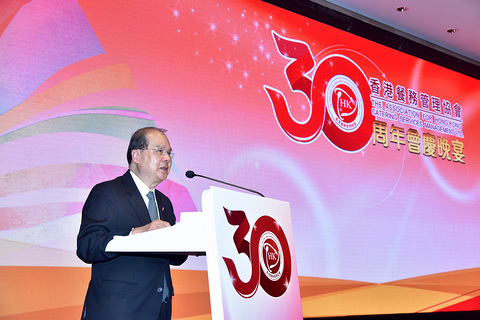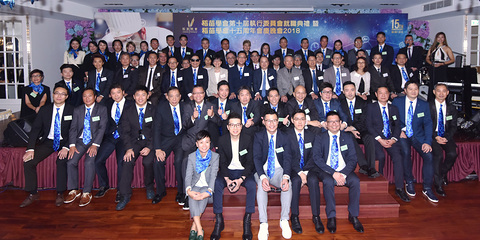Hong Kong: Culinary Capital
23 December 2018
 |
 |
 |
During the Christmas and New Year holidays, many people will seize the opportunity to share the festive joy with their family and friends, and more often than not enjoying a taste of delicious food in restaurants is a “must-do” for such gatherings.
Embracing both Chinese and Western food cultures, Hong Kong has lived up to its reputation as a gourmets’ paradise with nearly 18 000 eateries of all sizes offering a vast variety of cuisines of different countries. A great diversity of culinary delights suited for all budgets are offered everywhere in the city, from local snacks from street stalls to delicacies from Michelin-starred restaurants. Places to eat range from dai pai dongs (on street food stalls), noodle/congee stalls, siu mei shops (barbecue meat shops), Hong Kong-style tea cafes, fast food shops, Chinese restaurants and food stalls selling cuisines of different Chinese provinces and cities, to bistros, coffee shops and restaurants serving Western or other cuisines.
The catering industry is one of the key pillars of our tourism. It serves important economic and social functions while contributing to the promotion of Hong Kong as a livable city. The flourishing development of the catering industry is evidenced by the prevalence of eating establishments in almost every street and lane in the city. Based on the current population of approximately 7.45 million, it is estimated that there exists one restaurant for every 415 people in Hong Kong. This ratio highlights the high density and popularity of local restaurants.
As the Chinese saying goes, “food is the paramount necessity of the people.” Food and beverages play an integral role in our everyday life, for example, family reunions, festive celebrations, ceremonial occasions, gatherings with friends, business activities, staff meals and dim sum breakfasts loved by the retired elderly. According to statistics, Hong Kong’s restaurants yielded a total revenue of $59.3 billion in the first half of 2018, up 8.4% year-on-year.
Currently, there are about 246 000 people engaged in the catering industry, accounting for about 7% of the working population in Hong Kong (excluding foreign domestic helpers). To maintain our reputation as a gourmets’ paradise, the catering industry must seek continuous improvement by upgrading the quality of its workforce and nurturing more professionals.
The Government attaches great importance to manpower training and actively promotes vocational training for professionals to help young people unleash their potential and meet the manpower needs of Hong Kong. To provide training for students aspiring to pursue a culinary career and to enhance the professional standards of in-service practitioners, we will continue to offer structured training in Chinese cuisine through the Chinese Culinary Institute of the Vocational Training Council (VTC). In addition, an International Culinary Institute set up under the VTC was commissioned on 26 October 2018.
Well-equipped with state-of-the-art facilities, the International Culinary Institute offers a wide range of professional culinary programmes which attract renowned chefs and culinary experts from around the world to Hong Kong to engage in the training of local talent. This will not only foster and support the sustainable development of the catering, hospitality and tourism sectors in Hong Kong and the region, but also further strengthen our niche as a gourmets’ paradise.
Before the commissioning of the Institute, the culinary programmes were conducted in the training facilities of the VTC in Kowloon Bay, Pok Fu Lam and Tin Shui Wai. The opening of the Institute has made it possible for more comprehensive training to be provided for students. The number of students enrolled in the 2018/19 academic year is 1 170, representing an increase of about 250 students over the 2017/18 academic year. The most popular programmes are Higher Diploma in Culinary Arts and Higher Diploma in Baking and Pastry Arts.
As for part-time programmes, students can obtain recognised qualifications progressively while receiving professional training. The Professional Diploma in International Culinary Arts and Management, for example, is equivalent to Level 4 of the Qualifications Framework.
This year celebrates the tenth anniversary of the Hong Kong Qualifications Framework (HKQF). Over the last decade, the Government has built a solid infrastructure for a quality qualifications system by actively promoting the development of the HKQF. To further increase the capabilities of our young people and strengthen Hong Kong’s competitiveness, the Government injected $1.2 billion into the Qualifications Framework Fund earlier this year to enhance recognition of qualifications for different industries, with a view to achieving the target of “multiple pathways; masters of each trade”.
It is the Government’s policy to encourage the adoption of innovative technologies and ideas in the catering industry, so as to improve service standards and upgrade operations and management. Not only can this help relieve the pressure of manpower shortage facing Hong Kong, it can also enable the industry to combine innovative technologies with the traditional culinary art and quality service to drive the catering industry and tourism forward.
Healthy eating is a global trend. The Government published the Strategy and Action Plan to Prevent and Control Non-communicable Diseases (Action Plan) in May 2018, listing the targets to be achieved by 2025 with a view to containing the prevalence of raised blood pressure, heart attack, stroke, diabetes, obesity, etc.
I hope the catering industry will fully support the Action Plan and provide members of the public with healthy food prepared with less salt, sugar, oil and trans fats, so as to safeguard the health of Hong Kong people.

